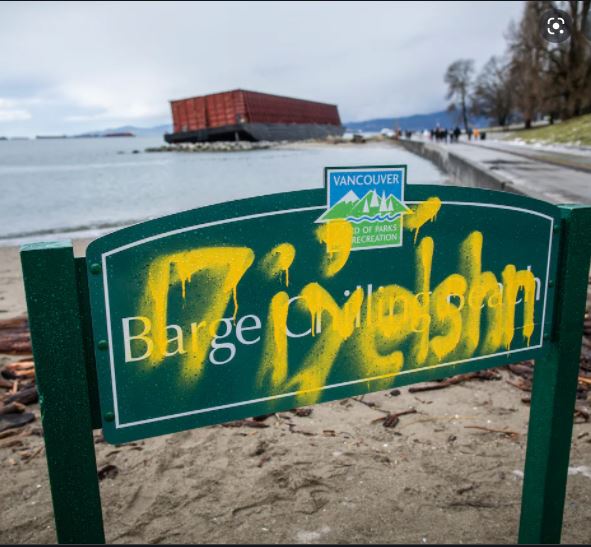In politics especially, when a word or phrase is used ambiguously, there are likely some ill-defined assumptions going along for the ride. Watch out: lack of clarity is a danger signal.
Today’s ambiguous word is ‘co-management.’ Here it is in a sentence – the one Park Board Commissioner Mackinnon moved in a motion for the board to consider:
(Staff is directed) to define and develop an implementation plan with Musqueam, Squamish, and Tseil-Waututh Nations for co-management of parklands within their traditional territories that are currently under Park Board jurisdiction ….
What does co-management mean?
Khelsilem, the Squamish Nation council chairperson, provided his definition in a recent tweet:
Co-management encompasses a spectrum of power-sharing arrangements. It usually refers to agreements between government agencies and representatives of Indigenous Peoples to jointly make land use and resource management decisions about areas of government-controlled land.
He believes the Park Board motion is “an exciting and worthwhile proposal … that could be a step along the path to full indigenous jurisdiction.”
That’s ultimately the power to make legal decisions determining the use and development of the parklands of Vancouver – a reversal of the current situation in which the elected Park Board governs and consults with First Nations. Under co-management and eventually “full indigenous jurisdiction”, First Nations would govern and the Parks Board would render opinion – or perhaps a contesting legal decision.
Or perhaps not. It’s ambiguous.
If “co-management” is essentially a relationship where the First Nations have an integrated advisory role in the operations of the board, but something less than a veto, then that currently exists. (There are three dedicated staff for the purpose). But final decision-making rests with the Park Board commissioners, who, even if they wanted to give it away, could not do so.
The Park Board has elected commissioners accountable to the citizenry who elected them. That might not be the case with indigenous co-managers. Under full indigenous jurisdiction, does taxation remain, but not representation? Critically, that ambiguity is about democratic accountability. If there isn’t any, then it’s not governing; it’s ruling.
Mackinnon and the progressive wing of the board have been effective at using their modest jurisdiction and powers to push the boundaries of social and political change, often with awkward consequences for senior governments that then have to take over whether they like it or not. When homeless camps are allowed full time in parks. When coyotes are kept in Stanley Park and people kept out. Ultimately it was the Province that moved in to resolve those issues that threatened public health, safety and trust, even though it was the inactions of the Park Board that created the instability. So here we go again.
With co-management, it will be fun times for progressive politics: Do names of parks get changed, statues removed (like Lord Stanley) and an agenda of decolonization play out on playing fields?
Justice may be done – but then attention will turn to some obvious conflicts of interest. If the Squamish had jurisdiction over Vanier Park, the site of their original reserve and adjacent to their Senakw project, how are the decisions they make presumably for the public good distinguishable from those that affect the value of their real estate – like the proposed access road through the park? Or are they there to justifiably maximize the interests of their nation? If there’s no electoral accountability, would it even matter?
So far governments have tried to navigate the ambiguity around indigenous title and rights without conceding, even when acknowledging unceded lands, that the meaning and expectations of Canadian citizenry are being negotiated as well. Like who determines the use of the parks. Or the planning of the city. Or the ownership of the land.
With one well-intended motion, meant to pass quietly, the Park Board could unleash some full-throated pushback – and more dilemmas for senior governments. Things could turn contentious during a civic election. And what constitutes the very idea of reconciliation itself may become … ambiguous.













Well said, Gordon. Every band within every First Nation has its own rules and governance structures, clear to them, not necessarily to non-members—witness the issues between elected and hereditary chiefs regarding the gas pipeline up north. The opportunity for misunderstanding is significant.
I’m not so sure there is a lot of ambiguity in the example given. The territory in question is unceeded – never been subjected to treaty or treaty definition. The hereditary chiefs are responsible to their peoples for its governance. The more lilited First Nations territories/jurisdictions were established by a foreign government under that government’s Indian Act. Their leaders and councils are governed by periodic votes of members and governed by the Government of Canada. The hereditary chiefs have never given up government of their territories.
Dear JefferyP
It should be noted that Vanier Park is territory that was properly and recently ceded to the Government of Canada in year 2000 by the Squamish Nation. It was part of a $92.5 million settlement that also included the establishment of Indian Reserve No. 6, currently known as Senakw. For reference:
https://www.theglobeandmail.com/news/national/squamish-band-settles-claim-for-925-million/article1041312/
Another of the hundreds of reasons that running a city government is not like running a bagel shop, or any other SMB.
It should be noted that Vanier Park is territory that was properly and recently ceded to the Government of Canada in year 2000 by the Squamish Nation. It was part of a $92.5 million settlement that also included the establishment of Indian Reserve No. 6, currently known as Senakw. For reference:
https://www.theglobeandmail.com/news/national/squamish-band-settles-claim-for-925-million/article1041312/
It should also be noted that the current value of Senakw is in excess of $1 billion.
I’m not sure that the original sin of the forced removal of the Squamish Nation from Kitsilano in 1913 can ever be ameliorated, but it should be acknowledged that a fairly reason amount of reparation has been forthcoming.
I don’t know if I am misconstruing this viewpoint out of all proportion to the implications embedded in the article. The points raise existential issues for not just the Park Board but also for the governance of Canada itself. The fear I have is that no one knows where we are going with sharing the land. Is it to be in proportion to the indigenous population (5%) or 50-50%. And what governance structure decides this division of land titles? By popular vote? Before making these nation defining statutes should there not be a revoking of the constitution based on a charter of rights including UNDRIP? If Quebec is lost in that process then so be it. Our national constitution should be based on a coalition of the willing not coercion of the culturally, politically and financially impoverished. Neither should our existing constitution be moulded by feckless feel-good political motions appealing to all those that natter on about giving thanks for those unceded lands we hold title to. This has to stop. We need to find our way with the help of the First Nations. The government doesn’t own the land, neither does anyone with a free title. And neither do the First Nations peoples. They have told us over and over again that no one owns the land regardless of titles originally dispensed by French priesthoods or later by the British. The government have been managers of land title only. The government has never owned the land and they never completed the treaty process. But before we all kick the sandcastle down let’s be clear we don’t want it replaced with a governance structure based on taxation without representation.
And now we see from the January 24 Park Board meeting that not until after the motion was made did Commissioner Stuart Mackinnon reach out to the three First Nations—and not one of them got back to him. January 19 when John Coupar spoke to Chief Wayne Sparrow was the first time the Musqueam leader had heard of the initiative. Does the Indigenous community even want this?
In fairness to Commissioner MacKinnon he did qualify his intent at the Monday Park Board meeting by declaring the motion as a way to start the conversation between the Park Board, the First Nations and the public. He repeated this intent at least three times during the meeting. I remain somewhat rankled by the fact that the conversation should be around the issue of governance first. Co management of the parks should be a secondary goal. At we should be clear that the governance is likely to vary between parks. Stanley Park governance by Vancouver Park Board and the Squamish? Hastings Park by the Park Board and Tsleil Waututh? Pacific Spirit by Metro Vancouver and the Musqueam. And so on. But there has to be some logic in governance and some accountability to taxpayers in co managing under the agreed governing structure.
If not governance, what should the conversation first be about?